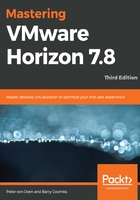
上QQ阅读APP看书,第一时间看更新
How the Blast Extreme connection process works
The following steps describe how the Blast Extreme connection process works:
- As with PCoIP, with Blast Extreme, the Horizon Client sends the end user's credentials for authentication via HTTPS to the external URL of the PCoIP external URL that you configured on the security server or Unified Access Gateway.
- HTTPS authentication data is passed through from either the Unified Access Gateway appliance or the security server to the connection server. The security server uses AJP13-forwarded traffic from the security server to the connection server it are paired with. The desktop pools and apps that the user is entitled to are read from the connection server and then displayed as available resources displayed in the Horizon client.
- The end user launches either a virtual desktop or published app session from the Horizon client. A session handshake occurs over HTTPS on TCP port 443 to the Unified Access Gateway Appliance or the security server.
- A secure WebSocket is established on TCP port 443) to allow the session data between the Horizon client and the Unified Access Gateway Appliance or the security server.
- The Blast Secure Gateway Service (either Unified Access Gateway Appliance or security server-based) will attempt to establish a UDP WebSocket connection on port 443. If the connection fails, or is blocked for some reason, then the Blast Secure Gateway Service will revert to the initial WebSocket TCP port 443 connection.
This process is shown in the following diagram:

For more detailed port settings, follow this link:
https://techzone.vmware.com/resource/network-ports-vmware-horizon-7.